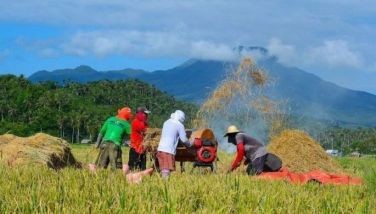Bayong: A fashionable alternative to plastic shopping bags
MANILA, Philippines - For many of us, the word bayong conjures trips to wet markets, haggling with vendors over the price of produce and meat, then returning home with these woven bags laden with a week’s worth of food.
The traditional bayong is woven from buri leaves in the Visayas and pandan in Luzon, according to Margie Pastrana, the pointperson for the Bayong Exhibit at the Product Development and Design Center of the Philippines.
She said the artists at the center came up with various takes on the bayong, including bayong-inspired furniture, in order to raise awareness that it is a viable and fashionable alternative to plastic shopping bags.
The bayong, according to a sign that greets viewers as they enter the exhibit area, “is valued more for function than for any expression of creativity or beauty.”
What the design center hopes to accomplish by the exhibit, which lasts until June 26, is to “resurrect usefulness and character that emanates from function and make.”
“Bayong in its totality has been updated and has different meanings to different people,” according to the sign. The bayong could be “a symbol of the cognizant consumer, a permanent fixation for the intelligent fashionista, and a memento of an exotic place or unique tradition for a tourist.”
Exploring new material
Designer Maria Felicitas Reyes explored the use of rattan split, abaca rope, seagrass and metal for her bayong-inspired furniture, which caught the eye of President Arroyo during the launch of another exhibit, this one a part of Laguna’s comprehensive livelihood emergency employment program for displaced employees of the province, at the Yazaki-Torres gymnasium in Calamba last April 24.
Reyes and Pastrana said Mrs. Arroyo was impressed by the lampshade, the shelves, the magazine rack/seat, and the stool.
Asked about the price, Reyes said since every item was handmade and these are just prototypes, they are more expensive compared to mass-manufactured furniture.
The center table costs P8,500; lampshade, P3,000; and the shelves, P5,500.
Designer Luis Manalang used sabutan and pandan leaves for the weave, and leather to reinforce his versions of the bayong.
Eduardo Delena, on the other hand, used buri, rattan and leather for his do-it-yourself bayong.
Trisha Anne Tejada designed a laptop bag and a “compartmentalized bayong” for wet and dry goods, both made from pandan. The laptop bag has a foam lining to protect the computer from the elements.
As for Rowe Requejo, she focused on making magazine racks and organizers as well as picnic and lunch baskets. She used fabric for the handles of her bamboo-woven baskets.
Inspired by the “tampipi,” the Filipino version of luggage, Arturo Delgado used pandan and leather for his organizers.
Pastrana said all the plant material used in the exhibit are from species that are plentiful in the country, and it is the designers’ skill and the technology used by the manufacturers that make them fashionable and functional.
She added that whoever is interested in mass-manufacturing the center’s designs may contact the center.
- Latest





























